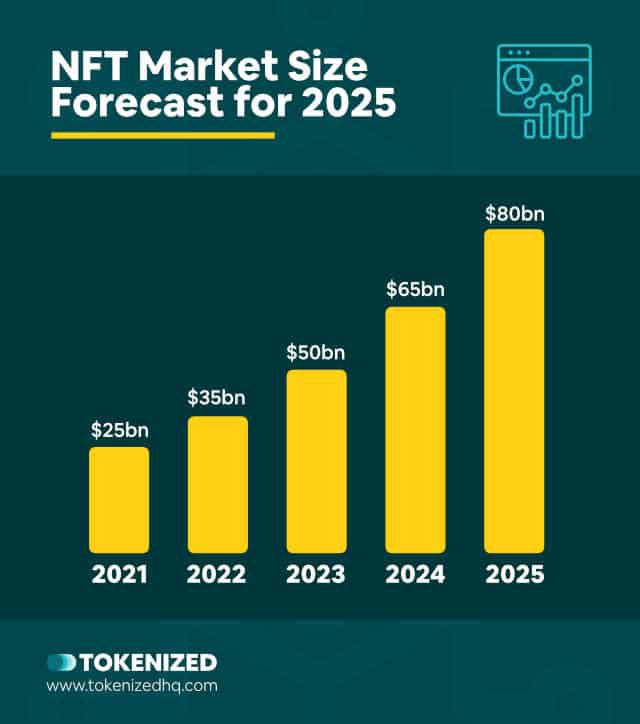The Future of NFTs: Winners and Losers in a Volatile Market

As we delve deeper into the dynamic world of NFTs, it is crucial to understand the driving forces behind their rise and fall. And learn to spot the marks of a promising NFT in a crowded digital market.
Here, we’ll examine the factors contributing to the volatility of the non-fungible token (NFT) market and discuss strategies for identifying long-term winners amid the turbulence.
A Rocky Path for NFTs
NFTs have had a wild ride in recent years. Once skyrocketing in value, they’ve since faced severe downturns. The NFT market now teeters on the brink, with economic instability casting doubt on its future.
The digital products gained widespread attention in 2021. Driven by high-profile sales, such as Beeple’s digital artwork selling for $69 million, and celebrity endorsements, the market enjoyed exponential growth. NFTs allowed artists, musicians, and other creators to monetize their work in unprecedented ways. However, this rapid ascent led to concerns about market saturation and speculative bubbles.
The NFT market’s volatility is hard to ignore. After meteoric rises, dramatic crashes followed. Today’s global economic conditions only exacerbate this instability. Inflation, supply-chain disruptions, and geopolitical tensions all contribute to the sense of uncertainty pervading the market.
For example, the COVID-19 pandemic left lasting marks on the global economy. Rising inflation rates and labor shortages have impacted consumer spending and business operations. These factors weigh heavily on the NFT market, which relies on discretionary spending. In fact, many Americans put government stimulus checks to work in both the crypto and non-fungible token markets.
Long-Term Viability
Despite challenges, NFTs have shown resilience. As the market matures, some indicators point to long-term potential. For instance, the recent surge in metaverse investments could bolster the NFT market. Virtual land, art, and collectibles could likely benefit from this newfound interest.
Facebook’s rebranding to Meta and the company’s commitment to developing the metaverse signals a broader trend. Major corporations, like Microsoft and NVIDIA, are also investing heavily in virtual reality and augmented reality technologies. These developments could translate into higher demand for NFTs, as digital goods become more integrated into everyday life.

Forecasted growth / Chart: Tokenized
The growing intersection of NFTs and decentralized finance (DeFi) also presents opportunities for growth. DeFi platforms allow users to lend, borrow, and trade digital assets without intermediaries. NFTs can be collateral for loans, enabling users to unlock liquidity without selling their prized possessions.
This convergence of NFTs and DeFi has given rise to innovative platforms like NFTfi and Aavegotchi, which combine elements of both worlds. By tapping into the DeFi ecosystem, the NFT market can find new avenues for growth and overcome some of its challenges.
Spotting the Winners
Investors must be cautious in this volatile market. Separating projects with long-term prospects from those doomed to fail is key. A few indicators can help:
- Utility: NFTs with practical applications, such as gaming assets or virtual real estate, may fare better than purely speculative tokens. For example, the popular blockchain game Axie Infinity utilizes NFTs as in-game assets, giving them inherent value.
- Rarity: Limited supply can drive demand, making rare NFTs more valuable. CryptoPunks, a collection of 10,000 unique pixel art characters, are a prime example of this dynamic in action.
- Quality: Artistic merit and creative innovation can set successful NFTs apart from the crowd. Projects like Art Blocks, which generates unique art pieces based on algorithms, stand out for their originality.
The Bigger Picture
The NFT market doesn’t exist in a vacuum. The broader context of cryptocurrency and stock market fluctuations has an impact on its future. As cryptocurrencies like Bitcoin and Ethereum face regulatory scrutiny and price volatility, the fate of NFTs, which often rely on these currencies, becomes even more uncertain.
Additionally, stock market turbulence can affect them. As investors seek safe havens in times of crisis, the NFT market may struggle to retain its allure.
Environmental Concerns
The environmental impact is another factor influencing their future. NFTs are predominantly minted on energy-intensive blockchain networks like Ethereum, which rely on the proof-of-work (PoW) consensus mechanism. The high energy consumption associated with PoW has raised concerns about sustainability.
In response, several projects are exploring more eco-friendly alternatives, such as proof-of-stake (PoS) networks, which require significantly less energy. Ethereum’s transition to PoS, known as Ethereum 2.0, could help address these concerns and potentially boost the market.
The Road Ahead
The NFT market faces numerous challenges, including market saturation, economic instability, and environmental concerns. However, with the growth of the metaverse, DeFi integration, and the emergence of eco-friendly blockchain networks, there is reason for cautious optimism.
Investors who carefully consider utility, rarity, and quality while assessing the market may stand a better chance of identifying winners in this volatile market. Although the future remains uncertain, the potential for innovation and growth should not be underestimated.






 Bitcoin
Bitcoin  Ethereum
Ethereum  Tether
Tether  USDC
USDC  TRON
TRON  Dogecoin
Dogecoin  Cardano
Cardano  Bitcoin Cash
Bitcoin Cash  Chainlink
Chainlink  Monero
Monero  LEO Token
LEO Token  Zcash
Zcash  Stellar
Stellar  Litecoin
Litecoin  Hedera
Hedera  Dai
Dai  Cronos
Cronos  Tether Gold
Tether Gold  OKB
OKB  Ethereum Classic
Ethereum Classic  KuCoin
KuCoin  Gate
Gate  Algorand
Algorand  Cosmos Hub
Cosmos Hub  VeChain
VeChain  TrueUSD
TrueUSD  Dash
Dash  Tezos
Tezos  Stacks
Stacks  IOTA
IOTA  Basic Attention
Basic Attention  Theta Network
Theta Network  Decred
Decred  NEO
NEO  Synthetix
Synthetix  Qtum
Qtum  Ravencoin
Ravencoin  DigiByte
DigiByte  0x Protocol
0x Protocol  Nano
Nano  Zilliqa
Zilliqa  Holo
Holo  Siacoin
Siacoin  Numeraire
Numeraire  Waves
Waves  Status
Status  BUSD
BUSD  Pax Dollar
Pax Dollar  Enjin Coin
Enjin Coin  Ontology
Ontology  Hive
Hive  Lisk
Lisk  Steem
Steem  Huobi
Huobi  OMG Network
OMG Network  NEM
NEM  Bitcoin Gold
Bitcoin Gold  Augur
Augur  Ren
Ren  HUSD
HUSD